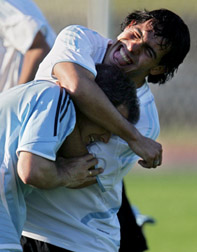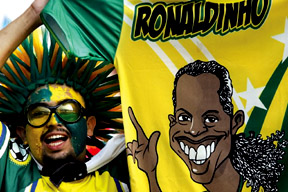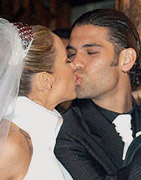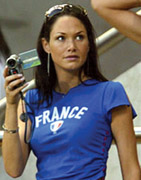|
observer |
|
|
|
|
|
OTHER LINKS |

|

|

|
2006 FIFA World Cup
The 18th FIFA World Cup will see eight new teams in the tournament, seven players preparing for their fourth World Cup match, the fifth oldest player in the history of the tournament - 40 year old Ali Boumnijel of Tunisia and England's Theo Walcott, 17 who will become the youngest ever scorer if he manages to find the back of a net. The 2006 World Cup will culminate on the 9th of July. Soccer's KnuckleballSoccer fans of a certain vintage will remember the Frido. The pimpled plastic soccer ball was the first cheap alternative to a leather ball, ideal for a kick about in the park. The Frido had two other advantages for a kid: If punctured, it could be repaired with the same kit used for fixing the inner tubes of bicycle tires; and when you kicked it, you could make it move around in the air in a way Beckham or Roberto Carlos could only dream of. We didn't care then about the theories of fluid dynamics that could have told us why. But heading into the 2006 World Cup, goalkeepers might want to dust off their old physics book, because the new ball being used in the tournament moves about in the air much more than a traditional soccer ball, is less predictable in its flight, and is more slippery in the wet. It could almost be a Frido. Actually, it is Adidas' new Teamgeist ball. When kicked by a world-class player who can impart the top or side spin that exploits the physics of making a ball swerve and dip in the air, the Teamgeist promises to tip the balance of power between the goalkeeper and the striker in the striker's favour. This should mean more goals, especially from swerving, dipping free kicks, which is partly the intention. The Teamgeist ball promises to provide more of the spectacular highlights that are the grist of TV's replay mill. A new ball has been developed for each World Cup since 1972. In place of the 32 pentagons and hexagons of synthetic leather that are stitched together to make a traditional ball, the Teamgeist uses 14 thermally bonded propeller-shaped panels. These reduce the number of seams by 60% and their total length by 15%, providing a smoother surface. Adidas claims that this surface, when allied with a new carcass construction, helps the ball stay rounder longer and perform more consistently, while giving the striker more accuracy and letting the ball retain more of the power imparted by a kick. Adidas says its thermal bonding technology also makes the ball virtually waterproof. When footballs get wet, they fly through the air more slowly, bounce less when they hit the ground (causing the infamous skid of a ball on wet pitches) and are more difficult for outfield players to bend. (It is no accident that the curving free kick was first perfected in sunny Brazil).
None of these innovations has necessarily cheered those whose job it is to keep the ball out of the net. Goalkeepers will face a ball that is lighter than they are used to, can be swerved and dipped more viciously, and is more difficult to grasp in wet conditions because of its plastic coating. England keeper Paul Robinson, who has practiced with the new ball for weeks, calls it "not goalkeeper friendly." Its least friendly aspect may be its potential for being struck unpredictably. While a kicker can now put more powerful spin on the ball to make it curve more, he will also find it easier to pull off an even more difficult manoeuvre-putting little or no spin on the ball while still striking it hard. Without spin and because the ball uses fewer panels, the Teamgeist behaves more like a baseball, which is constructed from only two panels. When thrown with little or no spin, a baseball bobs about in seemingly random ways as the seam intermittently breaks the boundary layer of air around the ball in flight, altering the aeromechanics and causing a deflection to its trajectory. In baseball, this pitch is known as a knuckleball, and neither pitcher nor batter has much idea of its exact flight path. World Cup goalkeepers now face the prospect of dealing with the equivalent of knuckleball pitches thrown at curveball speed. The net result should be more goals-and sales for Adidas of 15 million replicas of the $240 balls, more than twice as many as they sold after the 2002 World Cup. Facts - FIFA '06The opening match of the 2006 FIFA World Cup had the most goals of any opening match in FIFA history, with 6 goals (Germany 4; Costa Rica 2) compared to the next-best 1930 opening match with 5 goals (France 4; Mexico 1). Italy's 7-1 victory over the USA in 1934 was one of 8 simultaneous first round matches on the opening day and as such cannot be considered an opening match. The 2006 tournament will feature the most national teams making their first appearance in the World Cup finals (8) since there were ten first-time participants in the second competition in 1934. The eight national teams making their debut are Angola, Cote d'Ivoire, Czech Republic, Ghana, Serbia & Montenegro (16), Togo, Trinidad & Tobago, and Ukraine. This will be the first (18) World Cup with a team representing a country that has ceased to exist prior to the start of the tournament. Serbia and Montenegro split into Serbia and Montenegro in June 2006. The Serbia and Montenegro footballers will play under a flag no longer displayed in their countries. The team contains only one player born in Montenegro, Dragoslav Jevric (another Montenegrin, Mirko Vucinic, was forced to return home as a result of an injury). Australia is making its first appearance in 32 years, the longest such drought for any qualifier not making its first appearance. Carlos Gamarra's own goal in the match between Paraguay and England was the fastest own goal in World Cup history, and the 1-0 final score is the only 1-0 final score in World Cup history to have been decided by an own goal. The same match also saw the fastest goalkeeper substitution; Justo Villar suffered a calf injury in the 8th minute clearing a ball and had to be taken out of the game. The official logo design, The Smiling Faces, incorporates the logo of the 2002 FIFA World Cup: a stylised version of the FIFA World Cup Trophy. 2006 FIFA World Cup (video game) is the official computer and video game for the World Cup. As with the previous World Cup game, 2002 FIFA World Cup, it is being published by EA Sports. Adidas will supply personalized match balls for every match of the tournament. On each of these "Teamgeist" balls the date of the match and the names of the national teams involved will appear. The ball used for the final match will be a special gold colour. Hyundai Motor Company will supply 32 brand-new buses for use by the teams. To promote the tournament, a contest was held on the tournament's website. If a fan could supply a good slogan for their favourite team's bus, they would win tickets to the opening match. The 32 winning slogans were announced on May 22, 2006. Spanish is the language of 6 represented countries, more than any other language, including 5 countries where it is the official tongue (Argentina, Costa Rica, Ecuador, Paraguay and Spain), and one (Mexico) where it has de facto official status. This is followed by French, which is an official language in 5 (Cote d'Ivoire, France, Switzerland, Tunisia and Togo). English is the official language of 2 nations (Ghana and Trinidad & Tobago) and the de facto official language of an additional 3 (Australia, England, and the USA) for a total of 5. Portuguese is represented by 3 nations (Angola, Brazil and Portugal). German (Germany and Switzerland), Italian (Italy and Switzerland) and Arabic (Saudi Arabia and Tunisia) are each represented in 2. No other language has official status in more than one qualified nation. The long and short of itPlayers like their football shorts long At the 1994 World Cup in the USA, Jurgen Klinsmann himself was still in shorts. Who says men like short trousers? Things have changed since Beckenbauer's day: the shorts worn by today's players are nearly as long as Bermudas. The German eleven's traditional World Cup gear includes Adidas shorts: black with three white stripes. This time, they'll be adorned with fine yellow and red stripes recalling the German national colours, with three stars symbolizing the three World Cup titles Germany has won. While World Cup mascot Goleo is happy to go "bottomless", some professional players see no harm in wearing an extra pair of cycling shorts: they keep your muscles warm - and everyone has their own little quirks. "The shorts must be light", says Karl Quade, an expert on biomechanics at the Federal Institute of Sport Science (Bonn). And the garments must be able to withstand tussles between players without "revealing any male secrets", as Quade puts it. Some players even resort to wearing swimming trunks under their shorts - just to be on the safe side. The important thing, according to Quade, is that the material lets sweat through. That's why today's football shorts are made of microfibre and not of cotton, as they were back in 1954 when Helmut Rahn, in baggy shorts, scored the crucial goal that secured Germany's 3:2 victory over Hungary in the World Cup final in Bern. In the years that followed, the shorts got shorter - just take look at pictures of the winning German teams in 1974 and 1990. The brief Adidas model with the side slit and the satin look, sported by generations of players in the 1970s and 80s, is now little more than an object of nostalgia. The current preference for longer models is, according to Quade, primarily a matter of looks rather than function. The same trend can be observed in other sports such as tennis, where men are showing a lot less leg than in Bjorn Borg's day. "Shorts have become more functional, lighter and more breathable", says Adidas spokesman Oliver Bruggen when asked about football gear. Adidas in-house designer Patricia Papp came up with the model the national team will be wearing. It's made of a "highly breathable material" called "Climacool". Puma shorts are slightly longer at the back than at the front, so the players can sprint better, as spokesman Ulf Santjer explained. While Adidas has been clothing the German team for the last five decades, its rival from Herzogenaurach can claim to have kitted out the most World Cup teams (twelve), including the Italians. That football is not necessarily the place for cutting-edge fashion was a lesson the firm learned when it sent Cameroon's team to the 2004 African Cup of Nations in sexy one-piece outfits. The matter culminated in a legal battle with FIFA but was eventually settled out of court. The advantage of a one-piece outfit is that the shorts can't slip down. During the 1938 World Cup, Italy's star forward Giuseppe Meazza nearly ended up barelegged when taking a penalty in front of a crowd of 70,000 because the elastic had gone in his shorts. He still managed to score - holding his shorts up with his left hand. And here's another clothing-related anecdote from Christian Eichler's "Lexikon der Fuballmythen" (Dictionary of Football Myths), published by Piper: when goalkeeper Jens Lehmann, now Germany's number one, turned up for his first training session with the junior national team in jeans, the team's then junior coach Berti Vogts is said to have issued this warning: "Next time, make sure you're wearing proper trousers". For the 2006 World Cup, Gabriele Strehle has designed the suits the German players will be wearing off the pitch. What the fashion designer thinks of the Adidas shorts remains a secret: "Ms. Strehle won't comment on that", was the message from Strenesse in Munich. Divorce expert predicts soaring divorce rate if England fails to lift CupA divorce expert has predicted that divorce rates will soar if England fail to do well in the FIFA World Cup 2006. Mark Keenan, the Legal Director of online divorce service Divorce-Online based in the United Kingdom believes that the pressure on relationships that are failing can only get worse during the competition and has the statistics to prove it. Divorce-Online saw a 30% increase in divorce services requested after Japan Korea 2002 compared to the same period in 2001 and with the hype surrounding this World Cup the depression that would follow a bad campaign would simply be too much for some people. Transversely he believes that if England go all the way and lift the trophy, many marriages will be saved from the resulting feel good factor. (PRWEB) Thai monks given green light to watch World CupBANGKOK, June 14, 2006 (AFP) - Thailand's Buddhist monks must swear off many earthly pleasures, but the government has given them the green light to enjoy World Cup football, a religious affairs official said Wednesday. Thai monks will be allowed to watch the matches because exposure to worldly affairs including soccer is beneficial for their religious education, said Preecha Gunteeya, director of Thailand's Religious Affairs Department. But he added: "The must be clam and quiet, and there must be no gambling." World Cup 2006 live matches from Germany are broadcast late at night in football-mad Thailand, where officials say punters are expected to bet almost one billion dollars, 23 percent more than at the last cup four years ago. In neighbouring Cambodia, the chief Buddhist monk in the capital Phnom Penh on Monday warned that monks found watching the World Cup must be punished and kicked out from their pagodas. Raising their game
Ever dreamed of becoming a world-renowned sports star? Take a moment to contemplate the iconic status, the lavish lifestyle, the adoring fans and the glamorous spouse. If you happen to be a woman, you can have all that sans the athletic rigmarole. Simply get hitched to a world-class soccer player. Gone are the days when footballers' arm candy was rarely in the public eye. The wives of high-ranking soccer stars today are the focus of as much media fascination as their husbands. One reason is that footballers now earn the fortunes to move regularly in the worlds of fame and fashion. Model Kristen Park met her husband, twice European footballer of the year, Andriy Schvchenko, at a Giorgio Armani party. Next season, Schevchenko moves from AC Milan to Chelsea, where he will be earning upward of $5 million a year plus bonuses.
That is five times the average salary in the English Premier League, which has risen 65% since 2000, providing swelling disposable income for footballers' better halves to spend like water. Colleen McLoughlin, the fiancee of young England striker Wayne Rooney, is regularly snapped by the paparazzi whenever she emerges from designer boutiques laden with colourful shopping bags. The proliferation of celebrity media is another reason why the wives and girlfriends of soccer players have turned into a tabloid staple. "They've got these amazingly out-of-this-world, glamorous lives," says Jane Johnson, editor of Closer, a four-year-old women's weekly magazine heavily laced with celebrity news. "They drive the top of the range Mercedes, look immaculate and have a lifestyle which people want to emulate." But it is the uniquely competitive nature of their group that spurs soccer spouses to ever-greater heights of celebrity.
Yes, there are some common bonds-the joylessness of being shunted from country to country at the whim of the transfer market, the disappointment of broken metatarsals and the exclusion from the intensity of the all-male locker-room camaraderie. Yet throw the wives and partners together in a Germany hotel this summer and there will be intense pressure to out-bling, out-wax and out-exercise one another for the cameras. Mrs. Beckham, the Queen Bee of this hive, is reportedly packing five outfits for each day of the World Cup, in the knowledge that this could well be her husband's last international appearance. Mr. Beckham will not be the only one going out with a bang Victoria Beckham - wife of England's David Beckham Former Spice Girl, Mrs. Beckham, 32, is said to be the Queen Bee of the soccer wives. She met husband David a decade ago and they married three years later in a Dublin castle. They have three sons, Brooklyn, Romeo and Cruz. Claire Henry - wife of France's Thiery Henry Modeling under the name Nicole Merry, she appeared with her husband in Renault Clio's well-known "Va-va-voom" advert and has appeared in a film, The Fifth Element, as a stewardess. She and her husband live with their 1-year-old son, Tea, in an $11 million minimalist house in London's celebrity saturated Hampstead.
Kristen Pazik - wife of Ukraine's Andriy Schvchenko Pazik, a model, met her husband at a Giorgio Armani party. After a long courtship, they wed in July 2004 on a golf course in Washington D.C. Their son Jordan was born four months later, named after the basketball legend and Andriy's idol, Michael Jordan. Bianca Kajlich - fiancee of USA's Landon Donovan As an actress, she has appeared in Dawson's Creek and was famously dubbed in Halloween Resurrection because she reportedly can't scream. Her homesick fianc,e recently left one of Germany's top teams, Bayer Leverkusen, for Major League Soccer's LA Galaxy. Cheryl Tweedy - fiancee of England's Ashley Cole Nicknamed "Chezza" by U.K. tabloids, she is one fifth of the pop group Girls Aloud. Tweedy, 23, was recently voted Britain's toughest woman after a much publicized spat with voice-of-an-angel Charlotte Church and an alleged assault on a nightclub attendant. The couple intends to wed after the World Cup. Ilary Blasi - wife of Italy's Francesco Totti a former model and aspiring actress, Blasi, 25 works as a game show hostess on Italy's public service broadcaster RAI. She married Totto in 2005, and they had a son earlier this year. Helen Swedin - wife of Portugal's Louis Figo The Swedish Swedin, 30, lives in Milan, Italy, with her husband and three daughters. After moving to Barcelona at the age of 21, she met Figo in a local restaurant-he was the star of FC Barcelona and she was at the height of her modeling career. They married in 2001. Mamen Sanz - wife of Spain's Raul Mamen, a former model reportedly, branded Victoria Beckham as an "attention seeker" after the Beckhams moved to Spain on a transfer. Sanz has four sons with Raul, whom she met in a bar that he owned, and in which she worked as a waitress. Caroline Celico - wife of Brazil's Kaka Celico was 16 when she met Kaka, The pair were married in December last year in an evangelical church in Sao Paulo in front of 600 guests, including fellow Brazilian star, Ronaldo. The devout Kaka reportedly points heavenwards every time he scores a goal. Sepideh Mahdavikia - first wife of Iran's Mehdi Mahdavikia After eight years of marriage, she recently found out that her husband was married to another woman, after a chance meeting with another footballer's wife at a game in Hamburg. Sepideh chose to stick by her bigamous spouse, though the other wife, Samira, divorced him. Coleen McLoughlin - fiancee of Wayne Rooney The 20-year-old went from superchav to princess of haute couture after gracing the pages of Vogue magazine, and she writes a column for the celebrity magazine Closer. England's Rooney proposed to her at 17. Reports of his visits to a Liverpool brothel, prompted her to hurl a $46,500 diamond engagement ring into a squirrel sanctuary. Sylvie Meis - wife of Holland's Rafael van der Vaart Dutch TV broadcast the marriage ceremony last year of the television presenter and ex-model. Meis, 28, will probably not be watching her 23-year-old husband from the stands this World Cup as the couple are expecting their first child at the end of June. Anti-semitic chants aimed at her forced one referee to halt one of her husband's matches in 2004. Adriana Lavat - wife of Mexico's Rafael Marquez As an actress, she appears on Univision's wildly popular telenonvelas and also acts as a variety show host. She married Rafael, the youngest player to debut for Mexico and youngest captain, in 2001. They have a 3-year-old son, Santiago, and live in Europe. Rafael kisses a bracelet she gave him upon scoring a goal. Giselle Santa Cruz - wife of Paraguay's Rogue Santa Cruz As with England's Rooney, there's Paraguayan anxiety that her striker husband Rogue could see his star player status compromised in the cup thanks to some knee ligament damage. The pair was married in 2004 and has a son, Tobias, and daughter, Fiorella. Simone Lambe - girlfriend of Germany's Michael Ballack Lambe, 28, will be right at home as her German partner has been playing for Bayern Munich. They first met in a local cafe when Ballack played for Kaiserslautern cafe and have three sons, Louis, Emilio and Jordi Ballack is captain of the German team but will play his club football in England for Chelsea next year. Raica de Oliveira - girlfriend of Brazil's Ronaldo (could be a future wife?...) The 5'11" Brazilian model is the face of Victoria's Secret and Dior, and is the latest in a string of Ronaldo romances. Brazil's striker has been twice married. One ex-wife, Milene, won the 1998 world soccer-ball control championship for keeping a ball in the air for nine hours. A Soccer Ball- Brazil's Ronaldinho Gaucho For the man who is one of the greatest soccer players on the planet, it's hard to comprehend that the deific Ronaldinho is still void of a sparkling partner to flaunt off pitch. When asked at a press conference if he has a girlfriend, he took out the soccer ball and replied, "This is her." |
 In th is picture taken 12
June 2006,Brazilian player Ronaldo Nazario jokes during a training
session at the Olympic Stadium in Berlin. Brazil’s star striker
Ronaldo was taken to hospital in Frankfurt after feeling unwell at
the World Cup but medical tests showed nothing wrong with him, the
Brazil Football Confederation (CBF) said.The CBF said on its website
that the Real Madrid player started feeling unwell 14 June, after
the Brazilians had returned to their Konigstein base after the 1-0
win over Croatia in Berlin. The Brazilian medical team whisked him
off to a Frankfurt hospital, but he returned to join the squad after
medical tests cleared him and he was expected to train normally on
15 June.
In th is picture taken 12
June 2006,Brazilian player Ronaldo Nazario jokes during a training
session at the Olympic Stadium in Berlin. Brazil’s star striker
Ronaldo was taken to hospital in Frankfurt after feeling unwell at
the World Cup but medical tests showed nothing wrong with him, the
Brazil Football Confederation (CBF) said.The CBF said on its website
that the Real Madrid player started feeling unwell 14 June, after
the Brazilians had returned to their Konigstein base after the 1-0
win over Croatia in Berlin. The Brazilian medical team whisked him
off to a Frankfurt hospital, but he returned to join the squad after
medical tests cleared him and he was expected to train normally on
15 June.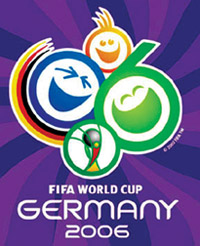 The quadrennial celebration of the world's most watched sport, the
FIFA World Cup is more than just football, in the same vein as football
being more than just "twenty-two hirelings kicking a leather ball" as
was suggested once. The 2006 FIFA World Cup will see the full spirited
participation of 736 footballers from 32 countries whose hopes and
prayers for the 31 days of the World Cup shall rest solely upon the
victory and glory that the World Cup brings.
The quadrennial celebration of the world's most watched sport, the
FIFA World Cup is more than just football, in the same vein as football
being more than just "twenty-two hirelings kicking a leather ball" as
was suggested once. The 2006 FIFA World Cup will see the full spirited
participation of 736 footballers from 32 countries whose hopes and
prayers for the 31 days of the World Cup shall rest solely upon the
victory and glory that the World Cup brings. 